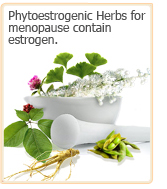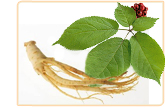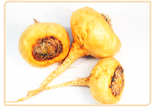Types of Menopause Herbs
 One of the most common natural remedies to help treat menopausal symptoms is herbs. Nowadays women, particularly those going through menopause, are interested in safe, alternative medicines. Menopause herbs are gaining popularity because hormone replacement therapy (HRT) causes many undesirable side effects and can also be very expensive. One of the most common natural remedies to help treat menopausal symptoms is herbs. Nowadays women, particularly those going through menopause, are interested in safe, alternative medicines. Menopause herbs are gaining popularity because hormone replacement therapy (HRT) causes many undesirable side effects and can also be very expensive.
Herbs for menopausal women can be separated into two different groups: Phytoestrogenic herbs and Non-estrogenic herbs. The Phytoestrogenic herbs for menopause contain estrogen while non-estrogenic herbs stimulate the body's own hormone production. Continue reading to learn more about these two types of herbs.
Phytoestrogenic Herbs
Phytoestrogenic herbs are plants that contain phytoestrogens, which have chemical structures similar to human estrogen. Some phytoestrogenic herbs for menopause are listed below.
 Black Cohosh: Due to its high levels of phytoestrogens, black cohosh is commonly used to help treat menopause symptoms, especially hot flashes. However, the phytoestrogens contained in black cohosh may stimulate the growth of breast tumors. Black Cohosh: Due to its high levels of phytoestrogens, black cohosh is commonly used to help treat menopause symptoms, especially hot flashes. However, the phytoestrogens contained in black cohosh may stimulate the growth of breast tumors.
 Dong Quai: The phytoestrogens in dong quai help to regulate the menstrual cycle and treat hormone-related menopausal symptoms. However, this herb is known to affect blood pressure and respiration when taken in large quantities. Dong Quai: The phytoestrogens in dong quai help to regulate the menstrual cycle and treat hormone-related menopausal symptoms. However, this herb is known to affect blood pressure and respiration when taken in large quantities.
 Ginkgo Biloba: Ginkgo Biloba is one of the oldest living tree species and one of the oldest herbal remedies for menopause. Chinese medicine has used ginkgo leaves and seeds for centuries to enhance memory performance and treat Alzheimer's disease. However, it can be toxic if prepared incorrectly. Ginkgo Biloba: Ginkgo Biloba is one of the oldest living tree species and one of the oldest herbal remedies for menopause. Chinese medicine has used ginkgo leaves and seeds for centuries to enhance memory performance and treat Alzheimer's disease. However, it can be toxic if prepared incorrectly.
 Ginseng: Ginseng is a root that enhances vitality, and is reputed to lengthen life span if taken on a regular basis. Ginseng increases levels of estrogen (a hormone that plays a role in several bodily functions) by substituting human hormones with phytoestrogens, botanical compounds with a chemical structure very similar to estrogen. It is amongst the most popular herbs that help with menopause. Ginseng: Ginseng is a root that enhances vitality, and is reputed to lengthen life span if taken on a regular basis. Ginseng increases levels of estrogen (a hormone that plays a role in several bodily functions) by substituting human hormones with phytoestrogens, botanical compounds with a chemical structure very similar to estrogen. It is amongst the most popular herbs that help with menopause.
 Red Clover: Red Clover is included in the list of herbs to take for menopause. It increases low levels of estrogen (a key hormone that plays a role in several bodily processes) by supplying the body with phytoestrogens, botanical compounds with a chemical structure very similar to that of human estrogen. Red Clover: Red Clover is included in the list of herbs to take for menopause. It increases low levels of estrogen (a key hormone that plays a role in several bodily processes) by supplying the body with phytoestrogens, botanical compounds with a chemical structure very similar to that of human estrogen.
Non-Estrogenic Herbs
As opposed to phytoestrogenic herbs, non-estrogenic herbs for menopause do not contain estrogen. These herbs stimulate the hormonal glands into naturally and efficiently producing hormones, resulting in fewer side effects.
 Macafem: Macafem is one of the most common non-estrogenic herbs for menopausal symptoms, and the only herb with studies proving its capacity to stabilize and stimulate hormone production. This herb is increasingly popular for treating menopause symptoms due to its hormone-balancing capacity. Click to learn more about Macafem. Macafem: Macafem is one of the most common non-estrogenic herbs for menopausal symptoms, and the only herb with studies proving its capacity to stabilize and stimulate hormone production. This herb is increasingly popular for treating menopause symptoms due to its hormone-balancing capacity. Click to learn more about Macafem.
Which herb should women try? Today women are looking for relief from their menopause symptoms with herbs. Phytoestrogenic herbs and non-estrogenic herbs are good in relieving menopause symptoms, but recent studies show that non-estrogenic herbs have no side effects because they help the body to produce its own hormones instead of introducing hormones like the phytoestrogenic ones. Learn more about non-estrogenic herbs for menopause. | 

